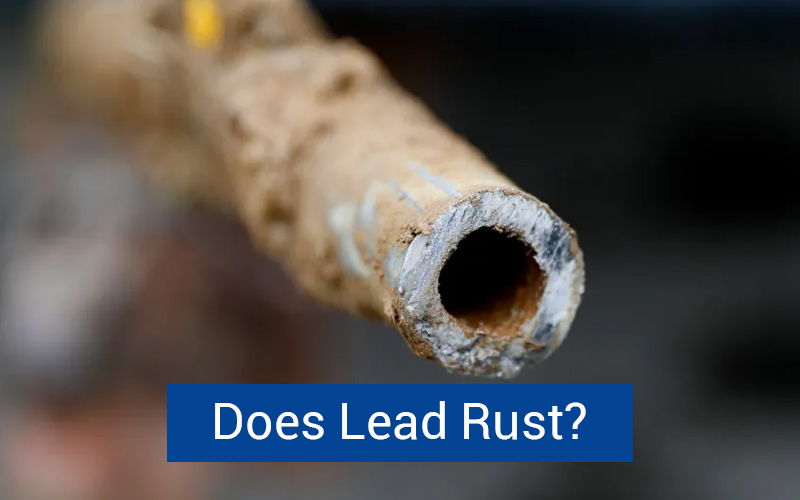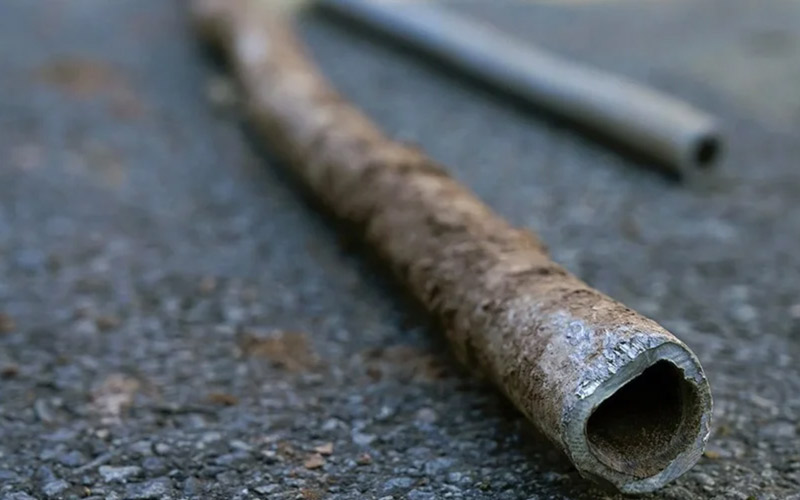Does lead rust? No, lead does not rust like iron. Instead, it forms a stable white-gray corrosion layer that protects the metal from further damage.
This guide explores why lead resists rust, how certain environments can still cause decay, and what safety precautions are essential. Learn to identify corrosion signs, assess water contamination risks, and consider safer modern alternatives for both health and structural use.

Contents
The Chemistry of Lead and Rust
This chapter concentrates on practical differences in their degradation, the chemistries of their corrosion sites in actual environments, and what these differences may mean to anybody handling the materials.
Lead Rusting vs Corrosion
Iron rusts; lead corrodes. If you help lead surfaces along to deteriorate, keep in mind you’ll see whitish-gray regolith, not reddish-brown flakes like we get with iron. The chemical reactions are different: lead creates protective layers such as lead carbonate (PbCO₃) or lead sulfate (PbSO₄), which mitigate further damage. If you find a white-gray film instead of red flaking, you’re seeing lead corrosion—the difference could matter for preservation or contamination control.
Reaction of Lead with Air and Moisture
Lead gradually develops a thin, adherent PbO layer under normal atmospheric conditions. In moist air, this can change to lead carbonate (white lead). And the slower the better: low humidity and clean air means the process doesn’t speed up. This environmental patina is the reason that ancient lead often survives much better than iron. Do not remove this patina during restoration; it is the most vital element of protection here.
Why Lead Doesn’t Rust Like Iron
Lead does not rust easily because it is of low reactivity and has a relatively stable atomic structure. The surface of stainless steel creates a robust coating compared to iron that just keeps flaking away. Considering the toxicity of lead, you will probably want to explore safer modern alternatives for most purposes unless particular corrosion resistance is required.
Finding and Learning About Lead Corrosion
This section offers practical advice for identifying and following lead corrosion in everyday environments.
How Lead Decays in Various Environments
In industrial regions, you may notice powdery white deposits on lead—evidence of lead sulfate from sulfur pollution. Close to the ocean, pitting and patchy corrosion is formed by chloride ions. Corrosion proceeds faster in acidic soil and slower in alkaline soil underground. Prior to physical installation or handling of any lead-containing components, you should evaluate the environment first.
Physical Indicators and Phases of Lead Decay
Initial corrosion is a dull gray film. Advancing results in chalky white encrustation, which can also flake. Severe degradation is seen as pitting or structural thinning, which requires replacement, especially in critical applications. Record changes to monitor any decline, or use corrosion testing methods for more accurate assessment.
Reasons for Quick Corrosion for Lead
Organic acids such as acetic acid readily attack lead, whereas mildly alkaline or phosphate-buffered solutions tend to leave the protective film intact. Galvanic corrosion results from contact with higher noble metals; separate with insulating components. Extreme temperature changes can crack the protective casing, so install flexibly wherever the temperature changes.
Lead in Water Systems
This section deals with the ways lead pipes interact with water, the dangers of manipulating water chemistry, and how to minimize the risk of contamination.
Why lead pipes in drinking water are bad: corrosion risk and prevention explained in two pages
Water that is rich in minerals like calcium and magnesium promotes the growth of protective scales inside lead pipes, but that scale can erode if water chemistry changes. Periodically check the lead level whenever a significant change in your water source occurs. In creating a stable barrier, utilities use orthophosphate; homeowners are advised to also use certified filters for additional protection, particularly during pipe replacements. Flush your lines thoroughly post partial line replacement to reduce the risk.
Action of Salt Water on Lead
Lead is quickly corroded in seawater by chlorides, higher oxygen, and is often subject to pitting. If working with marine finds or lead in a marine context, desalinate properly lead separated from other metals. Wash in fresh water to reduce salt corrosion and use sacrificial anodes where possible.
Techniques for Minimizing Lead in Water
Maintain water pH between 7.5 and 8.5 to minimize solubility of lead. At taps, install NSF-certified filters, according to manufacturers’ instructions, and maintain and change them out as needed. Flush pipes whenever water has been sitting idle, especially in older homes with lead lines.

Lead vs Other Metal
In this section, we will do a side-by-side comparison of the common metallic materials and their typical modes of deterioration, so you can select the right material for each application.
Rust Vs Corrosion: The Different Reactions of Metal
Every metal develops distinctive surface compounds as it breaks down—iron into rust red, lead into white, copper to green, aluminum to grey. Even galvanized steel can rust under the right conditions, despite its protective zinc coating. It may be useful to know the color and texture of the crust in choosing the appropriate method of protection. Iron, for instance, requires strict control of overall moisture, whereas lead likes stable humidity and clean air.
| Metal | Corrosion Process | Visual Appearance | Types Of Chemical Compounds Produced |
|---|---|---|---|
| Iron | Rusting (oxidation) | Reddish-brown flakes | Iron oxide (Fe₂O₃·nH₂O) |
| Lead | Corrosion | White-gray film | Lead carbonate (PbCO₃); Lead sulfate (PbSO₄) |
| Copper | Patination | Green-blue layer | Copper carbonate (CuCO₃·Cu(OH)₂) |
| Aluminum | Passivation | Dull gray film | Aluminum oxide (Al₂O₃) film |
Copper Vs Lead : Corrosion Resistance
Lead is more resistant to sulfuric acid than copper and so it is used for low concentration acid tanks. Copper, meanwhile, has better longevity in alkaline conditions. Choose based on your solution’s pH and the service environment. For outdoor lights, copper’s patina can provide more predictable long-term protection than lead’s.
Choice of Material: Lead Vs Modern Alternatives
“It is the new lead all water systems,” said Schreiber, who notes that PEX piping has replaced lead because it doesn’t corrode or have health risks. These are employed for lead-free radiation shielding in compliance with safety regulations using nontoxic bismuth-containing composites. In plumbing and electronics, lead-free solders (tin, silver, and copper) attain robust joint strength but require a bit more heat. Always verify compatibility and possibility to adapt the installation technique to new materials.
Preventing Environmental Damage of Lead
Discover actionable routines that will keep your lead components alive for the next 10-20 years, through maintenance focus and targeted protection for real life environments.
Tips for Lead Care and Endurance
Examine lead surfaces for evidence of the powdery white buildup and look for it at least quarterly throughout the year. Don’t neglect oxidation as it will only lead to more problems.
Wash as needed with pH-neutral mild liquid soap. Pass on harsh tools, which can remove the natural finish covering the metal underneath.
If you are in an industrial environment, maintain complete surface condition change records. This enables you to manage environmental problems before they become serious problems.
Defensive Coatings and Treatments
Prime with a metal primer that is formulated for lead to prevent moisture and acids. These primers change with temperature, yet remain completely sealed.
For outdoors, polyurethane and epoxy coatings provide excellent UV and water resistance. Reapply every several years depending on site conditions.
Use zinc-rich materials as sacrificial barriers in severe marine environments. Good coverage; must be fully and evenly cured for maximum protection.
Reducing Exposure Risks in the Environment
Keep unused lead in areas that are climate-controlled, with a humidity level of less than 60%. For short-term storage, enfold items in acid-free paper—moisture won’t be sealed within this catering equipment.
Do not install with materials containing acetic acid such as certain woods and adhesives. If unavoidable, install a barrier layer with special tape or film.
When it comes to installation in the ground, the use of sacrificial anodes and underground cathodic protection systems can redirect corrosive currents and maintain the integrity of the lead, particularly in high-electrolyte soils.
Health and Safety Issues
Receive useful tips to prevent health risks when working with corroded lead, identifying possible exposure, and using safe work practices.
Effect of Lead Corrosion on Water Quality
Lead decaying pipes and faucets cause water to leach lead, which can be harmful even at low levels. That risk increases if the water is acidic (below pH 7), which dissolves the protective coating inside pipes.
If your system has any lead plumbing, test the water quarterly. Focus on testing first-draw samples, after water has been in the line for a few hours.
At faucets where you drink water, consider installing point-of-use filters that are certified to remove lead. Change filters frequently to ensure you’ll always have a fresh supply of clean water.
Identifying and Managing Risk of Lead Exposure
Inspect plumbing joints, roof flashing and chalky, corroded painted surfaces. Take photos to help document and monitor changes over time.
If you suspect a material is made with lead, test it using EPA-recognized test kits before disturbing it. Such tests allow you to select the safest course for maintenance.
For those performing regular tasks, impose semi-annual testing for blood lead levels to detect exposure trends before symptoms develop.
Safe Handling and Proper Disposal of Corroded Lead
Always wear nitrile gloves, eye protection, and a P100 respirator when working with corroded lead. Do not cut or sand separately, as dust may form dangerous particles.
If you are performing removals, set up a contained workspace that includes plastic sheeting and negative air pressure. Use HEPA vacuums, not a broom, to clean up.
Discard waste through a licensed hazardous waste contractor. Close and clearly label all containers, and retain all disposal records for compliance.
Where Lead Is Used and the Importance of Rust
Notice how lead’s corrosion resistance is critical in actual applications in various sectors of industry.
Applications in Plumbing, Roofing & Beyond
Lead pipes were easy to shape and could be made tight but now have to be replaced because of the risks of corrosion and contamination of water in them.
Lead flashing is used in roofing to create durable waterproof barriers under and around chimneys and roof facets. With proper care, these seals will last for years and years.
| Industry | Lead Application | Corrosion Concern |
|---|---|---|
| Construction | Insulation, damping of radiation | Anything in which structural integrity is of critical importance (load bearing products) |
| Energy Storage | Battery plates and terminals | Conductivity lessened, disconnection |
| Marine | Ballast, subsea cable protection | Faster degradation in salt water conditions |
There is also lead in precision bearings and bushings for manufacturing purposes (due to its “self-lubricating” nature). Efficient control of corrosion keeps their dimensions within critical limits.
Why It Matters: Lead’s Resistance to Rust
This is due to the formation of a passive surface layer of lead acting as a barrier to further attack. This is the difference between it and metals such as iron, which rusts away completely once corrosion starts.
For electrical purposes, non-corrosiveness means a consistently conductive battery and cable sheathing. System performance is decreased when this defense does not work.
Preserving history depends on well-kept lead for original architectural details, ensuring authenticity in restored buildings for generations.
Lead Corrosion and Environmental Impact
Learn about lead corrosion in soil and water and its devastating environmental impact.
Impact on Soil and Water Systems
When lead corrodes it leaches into soil, where some of the heavy metal essentially gets absorbed by the soil organic matter and remains for decades. A lot of this lead stays near the shallow surface in long-term contamination spots.
Runoff washes lead into streams and lakes, damaging aquatic life even at extremely low levels. Some absorb so much lead that they experience damage to their nervous system.
Land contaminated with lead has reduced crop yields and represents a threat to food safety as crops can uptake and store lead from soil.
Long-Term Dangers to Ecosystems
Lead accumulates as it moves up the food chain, exposing predators to much higher levels, and harming the predators’ reproduction and survival.
Lead-enriched soils have lower microbial diversity, effectively impeding ecosystem recovery or natural nutrient cycles.
After active sources are brought under control, however, legacy contamination is still present and moving through the environment, thereby necessitating continued monitoring and application of treatment.
FAQ
Is Lead Highly Corrosive?
Lead is more resistant to corrosion than many other metals due to its formation of an oxide patina, which is protective. If amalgamated with other metals, and subjected to the influence of moisture, galvanic action might also arise. Dissimilar metals should be separated during fabrication to minimize the possibility of this.
For applications requiring good resistance to corrosion and also machinability, lead alloys containing antimony or tin are also very effective and help to enhance the protective oxide film.
Can Lead Surface Corrosion Be Treated or Repaired?
Lead doesn’t rust, but it does experience surface oxidation or corrosion, which can be eliminated. For mild tarnish, scrub with white vinegar and a soft brush, and rinse off immediately. More severe surface corrosion may be managed with fine abrasive pads or microblasting. Always apply a protective layer to lengthen the life of your components; this is particularly crucial if you are working in a tough environment.



